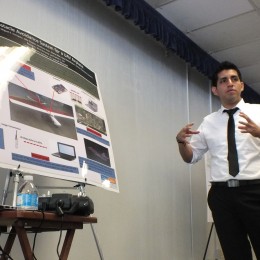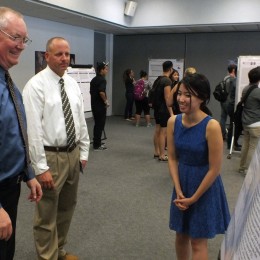
Students and the spoils of their summer research was on display on Sept. 17 in the Handy Campus Center, allowing students and faculty to see that Citrus students don’t just learn science, but are able to do science.
These 36 students with STEM majors, ranging in age from 19 to 27 performed research over the summer at five institutions in southern California, including Cal Poly Pomona, Cal State Fullerton and Oak Crest Institute of Science.
Race to STEM and (STEM)2 provided funding of $5,000 to each student for eight weeks of full-time work at the research facilities.

Victor Sanchez worked at Cal Poly Pomona in the aerospace engineering lab on object avoidance systems for unmanned aerial vehicles, or drones.
Victor worked on measurements of aircraft to build a prototype in a computer environment called Athena Vortex Lattice, allowing to thoroughly test the plane’s integrity prior to flight.
Though originally planning on transferring to CPP, Victor announced his acceptance to UCLA to study aerospace engineering.
When asked what helped with his research, “All the physics I never thought I’d use, I put into use every day” Victor said, “The classes I took at Citrus really prepared me for this research and my future at UCLA.”
Sarah Madero was also at CPP working on the genetics of the sea slug Dorid nudibranch.
The scientist’s interest in this creature is that they can eat toxic organisms, but repurpose the toxins for their benefit. Their prevalence over the Earth makes them a great model for evolution by natural selection.
Madero’s research focused on the phylogenetics of the slug, that is to study their evolutionary relationships within the group.
Her great relationship with the primary investigator has created an offer for a permanent position in the lab if she chooses to transfer to Cal Poly Pomona.“This [research] definitely confirms that this is what I want to do for my career.”

Susan Vong was at Cal State Fullerton this summer working at the Gravitational Wave Physics and Astronomy Center.
As a current physics major at Citrus, Vong was very excited to get to work in the field using data from LIGO, the Large Interferometer Gravitational-Wave Observatory, to measure how space is affected by neutron stars.
“This definitely helped decide what I wanted to do. I didn’t know what I wanted to do before, but the research helped my studies and fueled my determine to get my Ph.D,” Vong remarks regarding her future, now focusing on theoretical physics instead of experimental.
Jeff Lopez performed his research at CSU Fullerton as well, working with basil plants to study their ability to clean toxins out of soil, called phytoremediation.
The study was focused on a known carcinogen 1,4-Dioxane, which is a byproduct of aluminum manufacturing.
Using two control and three test groups of different soil concentrations, Lopez measured how well the basil absorbed the toxin, with great results.
Though his major is electrical engineering as a transfer student to CSUF, he notes, “Now that I have done this research, it helps connect the dots in all fields of science. I really appreciate it a lot more.”
Marianne Smith, Ph.D. the director of RACE to STEM and the principal investigator of (STEM)2, states that there were 90 strong applicants for the 36 positions in research, making the decision process difficult.
“[O]ur partner institutions are really terrific and offer our students extraordinary experiences allowing them to be mentored by scientists involved in cutting-edge research,” says Smith on the benefits for Citrus students involved in the research.
For the future, Smith suggests “preparing students for the experience by giving them more opportunity to access and read scientific journal articles before they start.”
The students at Citrus are understanding the natural world and are empowered to utilize this knowledge in scientific
research.
Applications for Summer Research Experience 2014 will be available in January of 2014.


